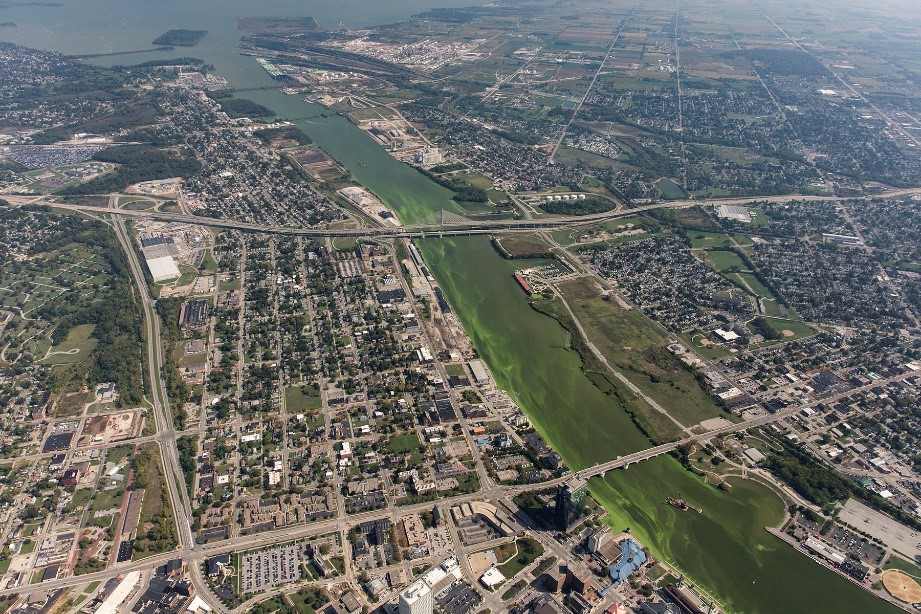

bringing runoff, high in nutrients, along for the ride. Credit: Annis Water Resources Institute-GVSU
While commending governments for establishing targets to reduce the amount of phosphorus entering Lake Erie, the IJC concluded in its first Triennial Assessment of Progress (TAP) report that the condition of water quality in Erie’s western basin is unacceptable.
In its 2014 Lake Erie Ecosystem Priority (LEEP) report, the IJC recommended that governments use more regulatory mechanisms and certification standards on nutrient pollution as a way to accelerate progress in reducing the size and intensity of harmful algal blooms in the lake’s western basin. The TAP report, released Nov. 28, 2017, further recommends mandatory standards and controls, and states that over the past 10-15 years, governments at all levels have been focused on incentive-based and voluntary programs to reduce nutrient loadings.
Other organizations such as the Alliance for Great Lakes and the Ohio Environmental Council counter that these voluntary programs aren’t enough to reach the 40 percent nutrient pollution reductions that the governments agreed to target.
Those groups – and the IJC – maintain that mandatory efforts are necessary to get harmful algal blooms under control, as 10-15 years of government supported voluntary measures haven’t resulted in meaningful improvements to Lake Erie’s water quality.
The federal governments, as well as the states and provinces that link to Lake Erie either directly or through tributaries – Michigan, Ohio, Ontario, Pennsylvania, New York and Indiana – have to come up with domestic action plans on how they’re going to help reach those 40 percent reduction targets. Some of those governments have already put draft plans forward, including Michigan, Ontario, Indiana and Ohio, but a reliance on voluntary programs in those three states and Ontario leaves the IJC skeptical that they can reach those targets as is.

This isn’t to say the IJC doesn’t find merit in these voluntary programs; the TAP reports that promoting incentive-based and voluntary best practices are a critical component to improving the health of Lake Erie. But the domestic action plans should include enforceable standards and timetables for reaching reduction goals, and measurable methods to quantify whether the state or provincial governments are hitting those benchmarks. This may include restoring lost wetlands or constructing new ones, which are an effective way to filter out nutrients before they reach the lake.
Lake Erie’s nutrient problems aren’t limited to the western basin, where phosphorus and other nutrients enter the lake primarily from the Maumee River, and to a lesser extent the Detroit River and the Thames River via Lake St. Clair. Although the problem is much worse in the western basin, pockets of nearshore nutrient and algae problems can be found around the lake. The TAP finds that a major source of nutrients (such as phosphorus) entering western Lake Erie are agricultural operations, including fertilizer applications and concentrated animal feeding operations (CAFOs). Legislative measures to address these sources have been limited; Ohio has passed legislation to keep manure and fertilizer from being placed in winter months to reduce runoff from CAFOs and farms, but there are still thousands of animal feeding operations in Michigan, Ontario and Ohio that aren’t required to get any kind of permit. The IJC’s Great Lakes Water Quality Board has a project underway to look at different manure regulations throughout the Lake Erie region, with a report expected in early 2018.

While agriculture is the primary contributor, failing and leaking septic systems and urban runoff are important sources of nutrient pollution, too. The IJC recommends governments require periodic testing, maintenance and replacement of septic systems in Canada and the United States. Urban nutrient runoff from pipes has declined over the past 40 years thanks to a concerted effort to upgrade sewer systems and close off other major direct single sources. But rainstorms and snowmelt can cause sewer overflows and nutrients from lawn care and construction activities to enter waterways. The IJC recommends the promotion and usage of green infrastructure (like rain gardens, filter strips, and engineered wetlands) to continue reducing runoff in those areas.
Finally, the IJC recommends that Ohio follow Michigan’s lead in declaring western Lake Erie impaired under the US Clean Water Act, which would require a tri-state maximum daily load of phosphorus be developed for those two states and Indiana, under US Environmental Protection Agency oversight. This would provide a mechanism to determine how much phosphorus can enter the water system without compromising water quality, and ultimately help restore the lake.
For its part, the IJC’s Great Lakes Water Quality Board and Science Advisory Board have been studying nutrient pollution issues in Lake Erie. These projects include comparing the influence of manure versus fertilizer, reviewing various policies on CAFOs and how progress toward nutrient reduction goals can be measured, as well as studying the link between nearshore nutrient enrichment and offshore nutrient declines.
Lake Erie’s nutrient problems aren’t improving, and more needs to be done to help the lake get healthy again.

Kevin Bunch is a writer-communications specialist at the IJC’s US Section office in Washington, D.C.




